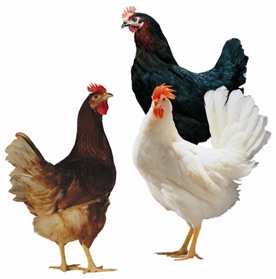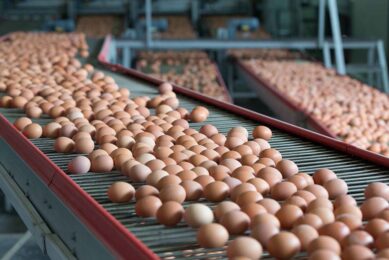Breeding for 500 eggs in 100 weeks

The onset of lay has long been an important characteristic for birds to mark the start of their productive life. Extending the laying cycle seems to be a possible and attractive new approach however. Institut de Sélection Animale (ISA) has the breeding programme in place to further improve laying persistency and egg quality at the end of the laying cycle. Longer cycles for birds, producing 500 eggs in 100 weeks, are well within reach.
By Frans van Sambeek, Technical Director ISA, Hendrix Genetics, Boxmeer, the Netherlands
Research and development (R&D) is the basis of a successful and profitable breeding programme for layers. It is also the basis for profitability of distributors and for the customers of the breeders’ customers: poultry farmers. R&D and genetic improvement are the core business of ISA. In all products the main breeding goal is maximum number of saleable eggs per hen housed. This is achieved through selection for long-term persistent laying rates, high liveability and excellent egg quality.
Developments in the layer business
The layer business is fast changing. In 2012 EU producers are compelled to adopt alternative housing systems as standard laying cages will no longer be permitted. In the USA, animal welfare activity is changing the production systems for table eggs. In some countries there is legal pressure for banning bird treatments such as beak trimming, de-combing and de-toeing. In many countries there is pressure on increased regulation or outright banning of the use of antibiotics.Increasingly, there is more emphasis on animal welfare involved with bird management, such as molting adult birds and killing male day old chicks in the layer hatcheries. More by-products such as distillers’ dried grains and canola from the biofuel industry are used as feed ingredients in layer diets. The call for more efficient use of resources continues to increase for feed, water, energy and land. Carbon footprint is also becoming an important issue.
The layer business is fast changing. In 2012 EU producers are compelled to adopt alternative housing systems as standard laying cages will no longer be permitted. In the USA, animal welfare activity is changing the production systems for table eggs. In some countries there is legal pressure for banning bird treatments such as beak trimming, de-combing and de-toeing. In many countries there is pressure on increased regulation or outright banning of the use of antibiotics.Increasingly, there is more emphasis on animal welfare involved with bird management, such as molting adult birds and killing male day old chicks in the layer hatcheries. More by-products such as distillers’ dried grains and canola from the biofuel industry are used as feed ingredients in layer diets. The call for more efficient use of resources continues to increase for feed, water, energy and land. Carbon footprint is also becoming an important issue.
Significant genetic improvement
In addition, we are seeing longer laying cycles for layer parent stock and commercial layers. During the last few decades the genetic improvement for egg production has been significant. In layer parent stock the genetic improvement was 0.5 to 1.0 day old chicks per breeder per year. This is a combination of genetic improvement and a longer laying cycle, increasing from 64 to 68 weeks, which results in an improvement of 15–20 day old chicks per breeder female since the 1980’s.For commercial layers, the genetic improvement is approximately 2.5 eggs per year. Together with the extension of the laying cycle from 68 to 75 weeks of age, this results in 70 more eggs in the last two decades. It is clear that this increase is realised by a combination of improved genetics, management, nutrition and disease prevention. Over the next decade ISA expects that the development of more genetic improvement and longer production cycles will continue. By approximately 2020, parent stock will produce about 120 day old chicks and the commercial layers will produce about 500 eggs in a production cycle of 100 weeks without molting.
Work for future environment
Currently brown-egg birds are kept to 80–85 weeks and white-egg birds in some markets to 85–90 weeks. Economic, genetic and animal welfare reasons play here an important role. Keeping the birds longer will decrease the contribution of the 17-week-old pullet to the cost/egg and there is less labour cost for housing and loading the layers. The revenue from the spent hens has decreased over the years and in the near future there will be pressure to prohibit molting because of animal welfare issues. From the genetic point of view, the laying persistency of commercial layers has improved, along with eggshell quality. High peaks of 97% combined with production above 90% until 50 to 60 weeks of age are not an exception. The overall performance of modern layers makes it possible to keep them longer.The layer business has to realise that because of the higher numbers of eggs per layer and the higher number of day old chicks per female breeder, the number of day old chicks to produce and the number of parent stock to be sold will decrease. This has a big impact on the economics of the egg value chain. A genetic company has to look ahead. The breeding programme has to work for the future environment; therefore ISA has adapted its breeding programme to the longer production cycles.
Currently brown-egg birds are kept to 80–85 weeks and white-egg birds in some markets to 85–90 weeks. Economic, genetic and animal welfare reasons play here an important role. Keeping the birds longer will decrease the contribution of the 17-week-old pullet to the cost/egg and there is less labour cost for housing and loading the layers. The revenue from the spent hens has decreased over the years and in the near future there will be pressure to prohibit molting because of animal welfare issues. From the genetic point of view, the laying persistency of commercial layers has improved, along with eggshell quality. High peaks of 97% combined with production above 90% until 50 to 60 weeks of age are not an exception. The overall performance of modern layers makes it possible to keep them longer.The layer business has to realise that because of the higher numbers of eggs per layer and the higher number of day old chicks per female breeder, the number of day old chicks to produce and the number of parent stock to be sold will decrease. This has a big impact on the economics of the egg value chain. A genetic company has to look ahead. The breeding programme has to work for the future environment; therefore ISA has adapted its breeding programme to the longer production cycles.
Breeding goals and genetic trends
For layers, the number of eggs produced is the main trait, but there are many more traits to select for. In general, for all products, egg size and body weight are already optimised, so no big changes are to be expected. The goal is breeding birds with a genetically more flat egg size curve. There is high selection pressure on several egg quality traits such as shell strength, shell surface properties, shell colour and internal egg quality. Genetic improvement of feed conversion takes place through additional egg mass output, and not through decreasing feed intake. The goal is to breed birds that are able to produce efficiently in different environmental circumstances, including hot climates.
For layers, the number of eggs produced is the main trait, but there are many more traits to select for. In general, for all products, egg size and body weight are already optimised, so no big changes are to be expected. The goal is breeding birds with a genetically more flat egg size curve. There is high selection pressure on several egg quality traits such as shell strength, shell surface properties, shell colour and internal egg quality. Genetic improvement of feed conversion takes place through additional egg mass output, and not through decreasing feed intake. The goal is to breed birds that are able to produce efficiently in different environmental circumstances, including hot climates.
Because liveability is an important trait, it receives continuous high selection pressure. This takes place through basic research (i.e. in the field of genomic selection) and field testing (such as recurrent testing in different environments). Because the strategy is to have a balanced focus on parent stock and final product traits, there is room reserved for selection on parent traits such as hatchability and chick quality. Next to these, selection for egg production is the most important. In most products there is no selection for increased early maturity. Peak production is already very high, so only minimal improvement can be expected. There has been a major selection focus on egg laying persistency, over the past several years. High peaks with production above 90% for many weeks are the result. This holds true for both commercial and parent stock.
New technology helpful
In order to further improve the number of saleable eggs per hen housed, which is selection for laying persistence, liveability and egg quality, ISA has added pure line breeding capacity. With this increased selection capacity, the pure line hens are kept until 100 weeks of age. The goal is to breed layers that produce 500 eggs in 100 weeks of age, without molting. In Figure 1 the longer production cycle is explained to increase the laying persistence. Many extra measurements are implemented between 75 and 100 weeks of age.
In order to further improve the number of saleable eggs per hen housed, which is selection for laying persistence, liveability and egg quality, ISA has added pure line breeding capacity. With this increased selection capacity, the pure line hens are kept until 100 weeks of age. The goal is to breed layers that produce 500 eggs in 100 weeks of age, without molting. In Figure 1 the longer production cycle is explained to increase the laying persistence. Many extra measurements are implemented between 75 and 100 weeks of age.
Figure 2 shows an example of the production curve of a pure line in the R&D farms. The pure line consists of three different ages. The line shows excellent performance with production above 90% until 65 weeks of age. But it is also clear that the production after 75 weeks can still be improved.
Figure 3 shows the distribution of the number of eggs produced by individual hens up to 100 weeks of age. It shows that there are already pure line birds that produce 500 eggs by 100 weeks of age. The frequency is still relatively small and the goal is to increase this percentage. ISA will achieve these goals through the regular measuring and breeding of pure line birds and recurrent test birds assisted by new technology. Through DNA research with a 60,000 SNP chip, breeding values will be estimated more accurately. Because laying cycles get longer, there is a tendency for the generation interval to increase. This is a disadvantage because it reduces the annual rate of genetic improvement. However, through genomic selection the generation interval can be progressively reduced.
Join 31,000+ subscribers
Subscribe to our newsletter to stay updated about all the need-to-know content in the poultry sector, three times a week. Beheer
Beheer








 WP Admin
WP Admin  Bewerk bericht
Bewerk bericht